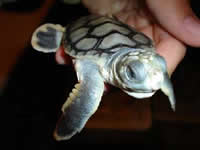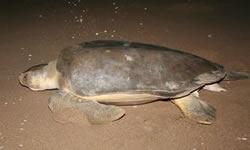Flatback turtle

Common name: Flatback turtle
Scientific name: Natator depressus
Family: Cheloniidae (sea turtles)
Description
The flatback turtle is grey or pale grey-green or olive above and creamy-yellow below. The head of adults is a moderate size and the thick overlapping carapace scales form an oval to heart-shaped shell. The carapace (shell) of an adult flatback turtle can grow up to one metre long. Hatchlings are olive-green and the margins of the dorsal scutes are broadly outlined in black. Adults can grow to up to 1.2 metres in length (head to tail).

Habitat and distribution
All known breeding sites of the flatback turtle occur in tropical Australia, on beaches and islands in Queensland, the Northern Territory and Western Australia. They feed in the northern coastal regions of Australia, ranging as far south as the Tropic of Capricorn. Their feeding grounds also extend to the Indonesian archipelago and the Papua New Guinea coast.
The Queensland Trust for Nature purchased Avoid Island, one of the three major breeding sites in eastern Australia for flatback turtles, and has established a Nature Refuge to protect the rookery and support further research and monitoring programs.
Life history and behaviour
Flatback turtles lay the fewest eggs of any marine turtle, with approximately 50 eggs per nest buried under the sand. Hatchlings break through the leathery shell of the egg at night, before digging together through the sand to the surface. Once on the surface of the beach, the hatchlings orientate themselves towards the lighter horizon of the ocean and then move as fast as they can down the beach and into the waves.
Early life for the hatchlings is precarious, as many are eaten by sharks and crocodiles, with few making it to adulthood. Flatbacks prefer inshore waters where they can feed in shallow sea-beds on a carnivorous diet of soft-bodied marine life such as soft corals, sea cucumbers, and jelly-fish. They return to the region of their origin to breed, with females then laying their eggs on a nesting beach.
Threatening processes
All marine turtle species are experiencing serious threats to their survival. Threats include:
- Feral pigs have been responsible for high levels of nest-predation with 90% of nests predated in west Cape York in the past. The pig's keen sense of smell allows them to locate buried turtle nests and subsequently dig up and consume all the contents.
- Nesting beaches are also disturbed by vehicles and coastal development. Uncontrolled vehicles can damage nests and disturb laying turtles. Light pollution at night from shops and houses can disorientate hatchlings causing them to move inland where they are easy prey for other animals.
- Pollution of waterways can impact on important turtle habitats, especially coral reefs.
- Despite the use of TEDs (Turtle Excluder Devices) in the fishing industry, many flatback turtles still drown in fishing equipment, such as discarded nets (also known as ghost nets).
Recovery actions
A national Recovery Plan for Marine Turtles in Australia exists and identifies the management actions necessary to recover marine turtle species in Australia.
Since 2014, the Nest to Ocean Turtle Protection Program has identified turtle rookeries for active nest protection and predator control efforts to reduce the threat posed by feral pigs and other predator species.
How you can help
- Report sick, injured, dead and/or tagged marine turtles to 1300 130 372. A Queensland Government officer in the relevant region will be contacted with your information and will determine the appropriate response.
- Remember that rubbish you throw away can find its way to the sea, where turtles can mistake things such as plastic bags for jellyfish. Plastic swallowed by mistake can cause blockages of the stomach and intestines of marine animals such as turtles.
- Follow the regulations relating to "go slow areas for turtles and dugong" including operating vessels off the plane and not undertaking motorised water sports. Many turtles are struck by propellers of speeding boats and this can cause injury and death.
- Be careful not to damage seagrass by careless anchoring or operating of a vessel in shallow water where boat wash or propeller damage can occur.
- Take care when fishing. Don't leave behind discarded fishing lines and don't use stainless steel hooks.
- Check crab pots regularly. Set your pots to avoid loose rope floating about in the water and ensure your pot entrances are not large enough to trap a turtle. Familiarise yourself with the guidelines on how to make a new crab pot, or learn how to correctly modify an existing one
- If you live adjacent to beaches in south Queensland, join your local Community Turtle Monitoring group and assist in protection and monitoring of turtle nests.
Related information
- Boat strike impact on turtle and dugong in Moreton Bay
- Commonwealth of Australia 2017 Recovery plan for marine turtles in Australia. Former Department of the Environment and Energy, Canberra.
- Department of the Environment and Energy (DOEE) 2017. Natator depressus Flatback turtle: in Species Profile and Threats Database. DOEE Canberra.
- Marine wildlife stranding
- Report on determining the spatial distribution and densities of marine turtle nesting and predator activity in the northern Great Barrier Reef.
- Turtle watching


